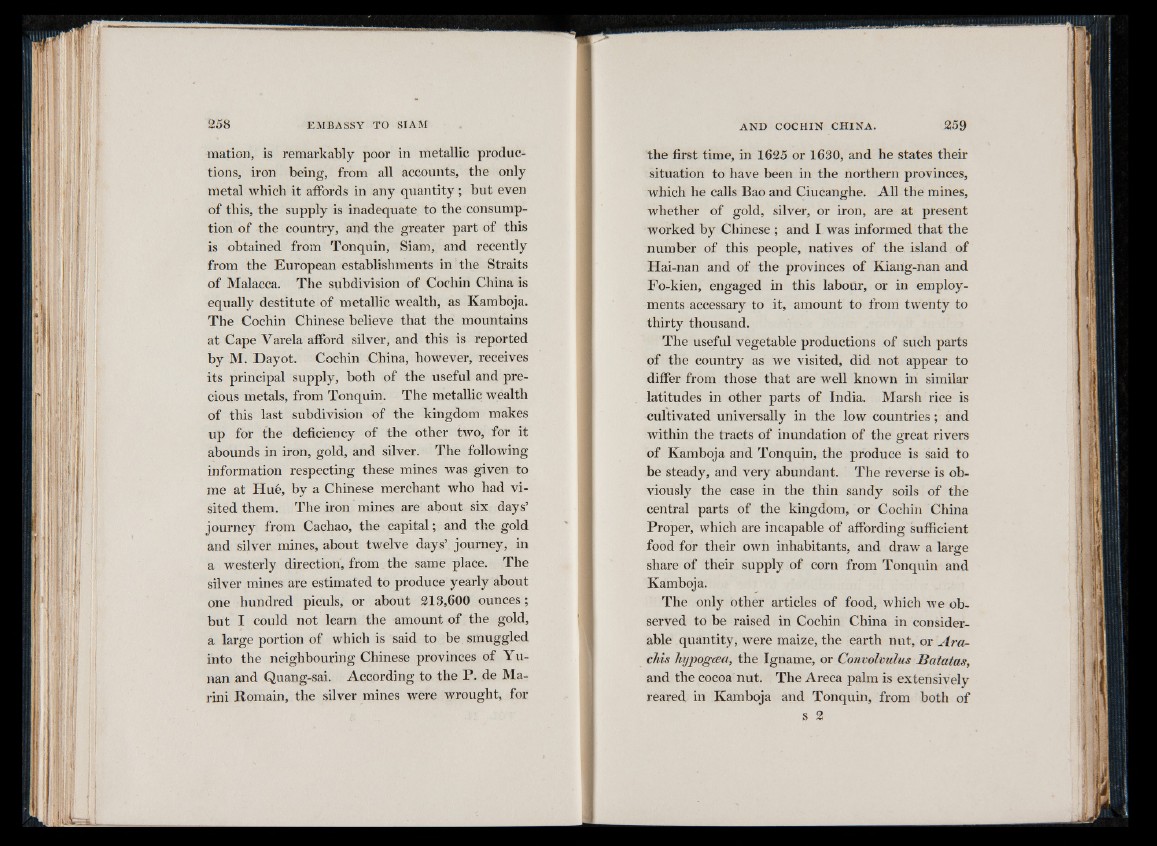
mation, is remarkably poor in metallic productions,
iron being, from all accounts, the only
metal which it affords in any quantity; but even
of this, the supply is inadequate to the consumption
of the country, and the greater part of this
is obtained from Tonquin, Siam, and recently
from the European establishments in the Straits
of Malacca. The subdivision of Cochin China is
equally destitute of metallic wealth, as Kamboja.
The Cochin Chinese believe that the mountains
at Cape Varela afford silver, and this is reported
by M. Dayot. Cochin -China, however, receives
its principal supply, both of the useful and precious
metals, from Tonquin. The metallic wealth
of this last subdivision of the kingdom makes
up for the deficiency of the other two, for it
abounds in iron, gold, and silver. The following
information respecting these mines was given to
me at Hue, by a Chinese merchant who had visited
them. The iron mines are about six days’
journey from Cachao, the capital; and the gold
and silver mines, about twelve days’ journey, in
a westerly direction, from the same place. The
silver mines are estimated to produce yearly about
one hundred piculs, or about 213,600 ounces;
but I could not learn the amount of the gold,
a large portion of which is said to be smuggled
into the neighbouring Chinese provinces of Yu-
nan and Quang-sai. According to the P. de Marini
Romain, the silver mines were wrought, for
the first time, in 1625 or 1630, and he states their
situation to have been in the northern provinces,
which he calls Bao and Ciucanghe. All the mines,
whether of gold, silver, or iron, are at present
worked by Chinese ; and I was informed that the
number of this people, natives of the island of
Hai-nan and of the provinces of Kiang-nan and
Fo-kien, engaged in this labour, or in employments
accessary to it, amount to from twenty to
thirty thousand.
The useful vegetable productions of such parts
of the country as we visited, did not appear to
differ from those that are well known in similar
latitudes in other parts of India. Marsh rice is
cultivated universally in the low countries; and
within the tracts of inundation of the great rivers
of Kamboja and Tonquin, the produce is said to
be steady, and very abundant. The reverse is obviously
the case in the thin sandy soils of the
central parts of the kingdom, or Cochin China
Proper, which are incapable of affording sufficient
food for their own inhabitants, and draw a large
share of their supply of corn from Tonquin and
Kamboja.
The only other articles of food, which we observed
to be raised in Cochin China in considerable
quantity, were maize, the earth nut, or A r Orchis
hypogcea, the Igname, or Convolvulus Batatas,
and the cocoa nut. The Areca palm is extensively
reared in Kamboja and Tonquin, from both of
s 2